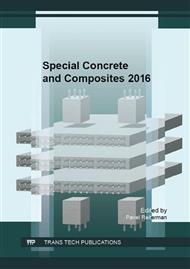[1]
Hegger, J., M. Zell, and M. Horstmann. Textile Reinforced Concrete–Realization in applications., proceedings: International fib Symposium Tailor Made Concrete Structures: New Solutions For Our Society. (2008).
DOI: 10.1201/9781439828410.ch61
Google Scholar
[2]
Hegger, J., et al. Exterior cladding panels as an application of textile reinforced concrete., ACI Special Publication 224 (2004).
Google Scholar
[3]
F. Vogel, O. Holčapek, P. Konvalinka, Study of the Strength Development of the Cement Matrix for Textile Reinf. Concrete, Advanced Materials Research 1054 (2014) 99-103.
DOI: 10.4028/www.scientific.net/amr.1054.99
Google Scholar
[4]
Brameshuber, Wolfgang, ed. Report 36: Textile Reinforced Concrete-State-of-the-Art Report of RILEM TC 201-TRC. Vol. 36. RILEM publications, (2006).
Google Scholar
[5]
Hegger, J., and S. Voss. Investigations on the bearing behaviour and application potential of textile reinforced concrete., Engineering structures 30. 7 (2008): 2050-(2056).
DOI: 10.1016/j.engstruct.2008.01.006
Google Scholar
[6]
M. Novotná, M. Kostelecká, J. Hodková, M. Vokáč, Use of Textile Reinforced Concrete – Especially for Facade Panels, Advanced Materials Research 923 (2014) 142-145.
DOI: 10.4028/www.scientific.net/amr.923.142
Google Scholar
[7]
Voss, S., & Hegger, J. (2006, September). Dimensioning of textile reinforced concrete structures. In J. Hegger, W. Brameshuber, & N. Will (Eds. ), Proceedings of the 1st International RILEM Symposium on textile reinforced concrete, RILEM Publication SARL, France (pp.151-160.
DOI: 10.1617/2351580087.015
Google Scholar
[8]
Heimbs, Sebastian, et al. Sandwich structures with textile-reinforced composite foldcores under impact loads., Composite structures 92. 6 (2010): 1485-1497.
DOI: 10.1016/j.compstruct.2009.11.001
Google Scholar
[9]
Hajek, P, Fiala, C, Kynclova, M. Life cycle assessment of concrete structures – a step towards environmental savings, Structural Concrete, Vol 12 (2011), Issue 1, ISSN 1464-4177: 13-22.
DOI: 10.1002/suco.201000026
Google Scholar
[10]
Fiala, C., Kynclova, M. Methodology of Life Cycle Assessment of Structures from High Performance Concrete, (in Czech) 9th conference Special Concrete, Skalsky dvur, Sekurkon, ISBN 978-80-86604-58-9, (2012): 55–62.
Google Scholar
[11]
L. Laiblová, T. Vlach, A. Chira, M. Novotná, C. Fiala, M. Ženíšek, P. Hájek, Technical Textiles as an Innovative Material for Reinforcing of Elements from High Performance Concretes (HPC), Advanced Materials Research 1054 (2014) 110-115.
DOI: 10.4028/www.scientific.net/amr.1054.110
Google Scholar
[12]
ČSN EN 12390-3: Zkoušení ztvrdlého betonu - Část 3: Pevnost v tlaku zkušebních těles, Vydavatelství ÚNM, Praha, (2009).
Google Scholar
[13]
ČSN EN 12390-5: Zkoušení ztvrdlého betonu - Část 5: Pevnost v tahu ohybem zkušebních těles, Vydavatelství ÚNM, Praha, (2009).
Google Scholar


